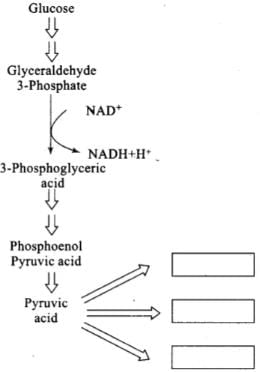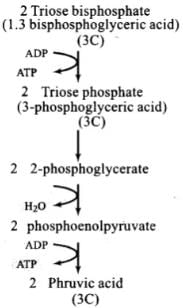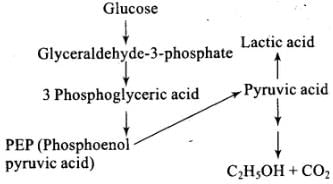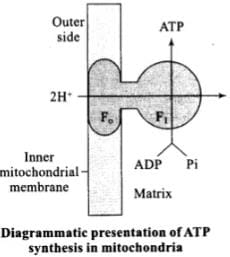NCERT Exemplars: Respiration in Plants | Biology Class 11 - NEET PDF Download
MULTIPLE CHOICE QUESTIONS
Q.1. The ultimate electron acceptor of respiration in an aerobic organisms is:
(a) Cytochrome
(b) Oxygen
(c) Hydrogen
(d) Glucose
Ans. (b)
Solution.
The ultimate electron acceptor of respiration in an aerobic organism is oxygen.
Q.2. Phosphorylation of glucose during glycolysis is catalysed by
(a) Phosphoglucomutase
(b) Phosphoglucoisomerase
(c) Hexokinase
(d) Phosphorylase
Ans. (c)
Solution.
Phosphorylation of glucose during glycolysis is catalyzed by hexokinase.
Q.3. Pyruvic acid, the key product of glycolysis can have many metabolic fates. Under aerobic condition it forms
(a) Lactic acid
(b) CO2 + H2O
(c) Acetyl CoA + CO2
(d) Ethanol + CO2
Ans. (c)
Solution.
Pyruvic acid, the key product of glycolysis can have many metabolic fates. Under aerobic condition it forms Acetyl CoA + CO2.
Q.4. Electron Transport System (ETS) is located in mitochondrial
(a) Outer membrane
(b) Inter membrane space
(c) Inner membrane
(d) Matrix
Ans. (c)
Solution.
Electron Transport System (ETS) is located in mitochondrial inner membrane.
Q.5. Which of the following exhibits the highest rate of respiration?
(a) Growing shoot apex
(b) Germinating seed
(c) Root tip
(d) Leaf bud
Ans. (b)
Solution.
Germinating seed exhibits the highest rate of respiration.
Q.6. Mitochondria are called powerhouses of the cell. Which of the following observations support this statement?
(a) Mitochondria synthesise ATP
(b) Mitochondria have a double membrane
(c) The enzymes of the Krebs cycle are found in mitochondria.
(d) Mitochondria are found in almost all plants and animal cells.
Ans. (a)
Solution.
Mitochondria are called powerhouses of the cell because mitochondria synthesise ATP.
Q.7. The end product of oxidative phosphorylation is
(a) NADH
(b) Oxygen
(c) ADP
(d) ATP+H2O
Ans. (d)
Solution.
The end product of oxidative phosphorylation is ATP+H2O.
Q.8. Match the following and choose the correct option from those given below.
| Column I | Column II |
| A. Molecular oxygen | i. α - Ketoglutaric acid |
| B. Electron acceptor | ii. hydrogen acceptor |
| C. Pyruvate dehydrogenase | iii. cytochrome C |
| D. Decarboxylation | iv. acetyl Co A |
Options
(a) A-ii, B-iii, C-iv, D-i
(b) A-iii, B-iv, C-ii, D-i
(c) A-ii, B-i, C-iii, D-iv
(d) A-iv, B-iii, C-i, D-ii
Ans. (a)
Solution.
| A. Molecular oxygen | (ii) Hydrogen acceptor |
| B. Electron acceptor | (iii) Cytochrome C |
| C. Pyruvate dehydrogenase | (iv) Acetyl Co A |
| D. Decarboxylation | (i) a-Ketoglutaric acid |
VERY SHORT ANSWER TYPE QUESTIONS
Q.1. Energy is released during the oxidation of compounds in respiration. How is this energy stored and released as and when it is needed?
Ans. Energy released during the oxidation of compounds in respiration is immediately stored in ATP in the form of chemical bonds.
ADP + iP + energy → ATP
As and when needed, this bond energy is broken and utilised
ATP → ADP + iP + energy
Q.2. Explain the term “Energy Currency”. Which substance acts as energy currency in plants and animals?
Ans. Every function of the cell requires energy. Energy currency stores and releases the energy as and when needed in the cell. ATP is called energy currency in both plants and animals.
Q.3. Different substrates get oxidized during respiration. How does Respiratory Quotient (RQ) indicate which type of substrate, i.e., carbohydrate, fat or protein is getting oxidized?
What do A and B stand for?
What type of substrates have R.Q. of 1, < 1 or > 1?
Ans. 
For fat and protein RQ is less than 1.
For carbohydrate RQ is 1.
RQ of organic acid is more than 1.
Q.4. F0 - F1 particles participate in the synthesis of ______.
Ans. F0 - F1 particles participate in the synthesis of ATP.
Q.5. When does anaerobic respiration occur in man and yeast ?
Ans. In alcoholic fermentation (by yeast), incomplete oxidation of glucose occurs under anaerobic conditions by sets of reactions where pyruvic acid is converted to ethanol and CO2.
PA → Ethanol + CO2
In animal cells also, like muscles during exercise, when oxygen is inadequate for cellular respiration pyruvic acid is reduced to lactic acid.
Q.6. Which of the following will release more energy on oxidation? Arrange them in ascending order.
(a) 1 gm of fat
(b) 1 gm of protein
(c) 1 gm of glucose
(d) 0.5 g of protein + 0.5g glucose
Ans.
Calorific values:
- Carbohydrate: 4.1 Kcal/g
Protein: 5.65
Fat: 9.45 kcal/g - Calorific value of 0.5 g of protein + 0.5 g glucose

- Ascending order of compounds: Glucose < ( Protein + Glucose) < Protein < Fat.
Q.7. The product of glycolysis (under hypoxia) in skeletal muscle and anaerobic fermentation in yeast are respectively ______ and ______.
Ans. The product of aerobic glycolysis in skeletal muscle and anaerobic fermentation in yeast are respectively pyruvic acid and ethanol + CO2.
SHORT ANSWER TYPE QUESTIONS
Q.1. If a person is feeling dizzy, glucose or fruit juice is given immediately but not a cheese sandwich Explain.
Ans. Glucose or fruit juice is absorbed easily through the alimentary canal. In the cells glucose is oxidised and energy is released immediately. A cheese sandwich provides energy after digestion and absorption which takes long time.
Q.2. What is meant by the statement “aerobic respiration is more efficient.”?
Ans. Aerobic respiration is more efficient because fermentation accounts for only a partial breakdown of glucose, whereas in aerobic respiration it is completely degraded to CO2 and H2O. Also, in fermentation there is a net gain of only two molecules of ATP for each molecule of glucose degraded to pyruvic acid, whereas many more molecules of ATP are generated under aerobic conditions.
Q.3. Pyruvic acid is the end product of glycolysis. What are the three metabolic products of pyruvic acid produced under aerobic and anaerobic conditions? Write their name in the space provided in the diagram.
Ans. (i) Under aerobic condition
CO2 + H2O is formed
(ii) Under anaerobic condition in our skeletal muscles lactic acid is formed
(iii) under anaerobic condition in yeast ethyl alcohol + CO2 is produced
Q.4. The energy yield in terms of ATP is higher in aerobic respiration than anaerobic respiration. Why anaerobic respiration occurs even in organisms that live in aerobic condition like human beings and angiosperms?
Ans. Anaerobic respiration even in organisms that live in aerobic condition like human beings and angiosperms due to the oxygen deficiency. In our skeletal muscles during strenuous exercise oxygen deficiency leads to anaerobic respiration. In germinating seeds anaerobic respiration leads to release of energy for emerging the seedling from the soil.
Q.5. Oxygen is an essential requirement for aerobic respiration but it enters the respiratory process at the end? Discuss.
Ans. Although the aerobic process of respiration takes place only in the presence of oxygen, the role of oxygen is limited to the terminal stage of the process. Yet, the presence of oxygen is vital, since it drives the whole process by removing hydrogen from the system. Oxygen acts as the final hydrogen acceptor.
Q.6. Respiration is an energy releasing and enzymatically controlled catabolic process which involves a step-wise oxidative breakdown of organic substances inside living cells.
In this statement about respiration explain the meaning of
(i) Step-wise oxidative breakdown, and
(ii) Organic substances (used as substrates)
Ans. (i) Step-wise oxidative breakdown: During oxidation within a cell, all the energy contained in respiratory substrates is not released free into the cell, or in a single step. It is released in a series of slow step-wise reactions controlled by enzymes, and it is trapped as chemical energy in the form of ATP. Hence, it is important to understand that the energy released by oxidation in respiration is not (or rather cannot be) used directly but is used to synthesise ATP, which is broken down whenever (and wherever) energy needs to be utilised.
(ii) Organic substances (used as substrates): The compounds that are oxidised during this process are known as respiratory substrates. Usually carbohydrates are oxidised to release energy, but proteins, fats and even organic acids can be used as respiratory substances in some plants, under certain conditions.
Q.7. Comment on the statement – Respiration is an energy producing process but ATP is being used in some steps of the process.
Ans. In the respiration pathway, there are some steps where energy is utilised for phosphorylation. For example, conversion of glucose to glucose-6-phosphate consume one ATP. But at the end of the respiratory process many more ATP are produced.
Q.8. The figure given below shows the steps in glycolysis. Fill in the missing steps A, B, C, D and also indicate whether ATP is being used up or released at step E?
Ans.
Q.9. Why is respiratory pathway referred to as an amphibolic pathway? Explain.
Ans. During breakdown and synthesis of protein, respiratory intermediates form the link. Breaking down processes within the living organism is catabolism, and synthesis is anabolism. Because the respiratory pathway is involved in both anabolism and catabolism, it would hence be better to consider the respiratory pathway as an amphibolic pathway rather than as a catabolic one.
Q.10. We commonly call ATP as the energy currency of the cell. Can you think of some other energy carriers present in a cell? Name any two.
Ans. Yes, some other energy carriers are also present in a cell like GTP (guanosine triphosphate), ADP (adenosine diphosphate) and creatine phosphate.
Q.11. ATP produced during glycolysis is a result of substrate level phosphorylation. Explain.
Ans. ATP produced during glycolysis is a result of substrate level phosphorylation because these ATP are produced without the electron transport system (ETS) and chemiosmosis.
During substrate level phosphorylation ATP is directly synthesised from ADP and inorganic phosphate (iP).
Q.12. Do you know any step in the TCA cycle where there is substrate level phosphorylation. Which one?
Ans. During TCA cycle there is one step where substrate level phosphorylation takes place. This occurs during conversion of succinyl-CoA to succinic acid.
Q.13. A process is occurring throughout the day, in ‘X’ organism. Cells are participating in this process. During this process ATP, CO2 and water are evolved. It is not a light-dependent process.
(a) Name the process.
(b) Is it a catabolic or an anabolic process?
(c) What could be the raw material of this process?
Ans. (a) Respiration
(b) Catabolic process (actually amphibolic pathway)
(c) Glucose
Q.14. When a substrate is being metabolized, why does not all the energy that released in one step. It is released in multiple steps.What is the advantage of step-wise release?
Ans. The complete combustion of glucose, which produces CO2 and H2O as end products, yields energy most of which is given out as heat.
C6H12O6 + 6O2 → 6CO2+ 6H2O + Energy
If this energy is to be useful to the cell, it should be able to utilise it to synthesise other molecules that the cell requires. The strategy that the plant cell uses is to catabolise the glucose molecule in such a way that not all the liberated energy goes out as heat. The key is to oxidise glucose not in one step but. in several small steps enabling some steps to be just large enough such that the energy released can be coupled to ATP synthesis.
Q.15. Respiration requires O2. How did the first cells on the earth manage to survive in an atmosphere that lacked O2?
Ans. During the process of respiration, oxygen is utilised, and carbon dioxide, water and energy are released as products. The combustion reaction requires oxygen. But some cells live where oxygen may or may not be available. There are sufficient reasons to believe that the first cells on this planet lived in an atmosphere that lacked oxygen. Even among present-day living organisms, we know of several that are adapted to anaerobic conditions.
Q.16. It is known that red muscle fibres in animals can work for longer periods of time continuously. How is this possible?
Ans. Muscle contains a red coloured oxygen storing pigment called myoglobin. Myoglobin content is high in some of the muscles which gives a reddish appearance. Such muscles are called the Red fibres. These muscles also contain plenty of mitochondria which can utilise the large amount of oxygen stored in them for ATP production. These muscles, therefore, can also be called aerobic muscles.
Q.17. The energy yield in terms of ATP is higher in aerobic respiration than during anaerobic respiration. Explain.
Ans. The energy yield in terms of ATP is higher in aerobic respiration than during anaerobic respiration because fermentation (anaerobic respiration) accounts for only a partial breakdown erf glucose, whereas in aerobic respiration it is completely degraded to CO2 and H2O. So, in fermentation there is a net gain of only two molecules of ATP for each molecule of glucose degraded to pyruvic acid, whereas many more molecules of ATP are generated under aerobic conditions.
Q.18. RuBP carboxylase, PEP carboxylase, Pyruvate dehydrogenase, ATPase, cytochrome oxidase, Hexokinase, Lactate dehydrogenase.
Select/choose enzymes from the list above which are involved in
(a) Photosynthesis
(b) Respiration
(c) Both in photosynthesis and respiration
Ans. (a) Photosynthesis: RuBP carboxylase, PEP case, ATPase
(b) Respiration: Hexokinase, ATPase, Pyruvate dehydrogenase, Cytochrome oxidase
(c) Both in photosynthesis and respiration: ATPase
Q.19. How does a tree trunk exchange gases with the environment although it lacks stomata?
Ans. In stems, the ‘living’ cells are organised in thin layers inside and beneath the bark. They also have openings called lenticels. The cells in the interior are dead and provide only mechanical support. Thus, most cells of a plant have at least a part of their surface in contact with air. This is also facilitated by the loose packing of parenchyma cells in leaves, stems and roots, which provide an interconnected network of air spaces.
Q.20. Write any two energy yielding reactions of glycolysis.
Ans. The conversion of BPGA to 3-phosphoglyceric acid (PGA), is an energy yielding process; this energy is trapped by the formation of ATP. Another ATP is synthesised during the conversion of PEP to pyruvic acid.
Q.21. Name the site (s) of pyruvate synthesis. Also, write the chemical reaction where in pyruvic acid dehydrogenase acts as a catalyst.
Ans. Pyruvate synthesis takes place in cytoplasm.
Q.22. Mention the important series of events of aerobic respiration that occur in the matrix of the mitochondrion and in the inner membrane of the mitochondrion.
Ans. For aerobic respiration to take place within the mitochondria, the final product of glycolysis, pyruvate is transported from the cytoplasm into the mitochondria. The crucial = events in aerobic respiration are:
The complete oxidation of pyruvate by the stepwise removal of all the hydrogen atoms, leaving three molecules of CO2.
The passing on of the electrons removed as part of the hydrogen atoms to molecular 02 with simultaneous synthesis of ATP. What is interesting to note is that the first process takes place in the matrix of the mitochondria while the second process is located on the inner membrane of the mitochondria.
Q.23. Respiratory pathway is believed to be a catabolic pathway. However, nature of TCA cycle is amphibolic. Explain.
Ans. During breakdown and synthesis of protein, respiratory intermediates form the link. Breaking down processes within the living organism is catabolism, and synthesis is anabolism. Because the respiratory pathway is involved in both anabolism and catabolism, it would hence be better to consider the respiratory pathway as an amphibolic pathway rather than as a catabolic one.
LONG ANSWER TYPE QUESTIONS
Q.1. In the following flow chart, replace the symbols a,b,c and d with appropriate terms. Briefly explain the process and give any two application of it.
Ans.
Q.2. Given below is a diagram showing ATP synthesis during aerobic respiration, replace the symbols A, B, C, D and E by appropriate terms given in the box.
Ans.
Q.3. Oxygen is critical for aerobic respiration. Explain its role with respect to ETS.
Ans. Although the aerobic process of respiration takes place only in the presence of oxygen, the role of oxygen is limited to the terminal stage of the process. Yet, the presence of oxygen is vital, since it drives the whole process by removing hydrogen from the system. Oxygen acts as the final hydrogen acceptor. Unlike photo phosphorylation where it is the light energy that is utilised for the production of proton gradient required for phosphorylation, in respiration it is the energy of oxidation-reduction utilised for the same process. It is for this reason that the process is called oxidative phosphorylation.
Q.4. Enumerate the assumptions that we undertake in making the respiratory balance sheet. Are these assumptions valid for a living system? Compare fermentation and aerobic respiration in this context.
Ans. The Respiratory Balance Sheet:
It is possible to make calculations of the net gain of ATP for every glucose molecule oxidised; but in reality this can remain only a theoretical exercise. These calculations can be made only on certain assumptions that:
There is a sequential, orderly pathway functioning, with one substrate forming the next and with glycolysis, TCA cycle and ETS pathway following one after another.
The NADH synthesised in glycolysis is transferred into the mitochondria and undergoes oxidative phosphorylation.
None of the intermediates in the pathway are utilised to synthesise any other compound.
Only glucose is being respired – no other alternative substrates are entering in the pathway at any of the intermediary stages. But this kind of assumptions are not really valid in a living system; all pathways work simultaneously and do not take place one after another; substrates enter the pathways and are withdrawn from it as and when necessary; ATP is utilised as and when needed; enzymatic rates are controlled by multiple means. Yet, it is useful to do this exercise to appreciate the beauty and efficiency of the living system in extraction and storing energy. Hence, there can be a net gain of 36 ATP molecules during aerobic respiration of one molecule of glucose.
Q.5. Give an account of Glycolysis. Where does it occur? What is the end product? Trace the fate of these products in both aerobic and anaerobic respiration.
Ans. Glycolysis occurs in the cytoplasm of the cell and is present in all living organisms. In this process, glucose undergoes partial oxidation to form two molecules of pyruvic acid. In plants, this glucose is derived from sucrose, which is the end product of photosynthesis, or from storage carbohydrates. Sucrose is converted into glucose and fructose by the enzyme, invertase, and these two monosaccharides readily enter the glycolytic pathway. Glucose and fructose are phosphorylated to give rise to glucose-6-phosphate by the activity of the enzyme hexokinase. This phosphorylated form of glucose then isomerises to produce fructose-6-phosphate. Subsequent steps of metabolism of glucose and fructose are same. In glycolysis, a chain of ten reactions,under the control of different enzymes, takes place to produce pyruvate from glucose. Pyruvic acid is then the key product of glycolysis. The metabolic fate of pyruvate depends on the cellular need. There are three major ways in which different cells handle pyruvic acid produced by glycolysis. These are lactic acid fermentation, alcoholic fermentation and aerobic respiration. Fermentation takes place under anaerobic conditions in many prokaryotes and unicellular eukaryotes. For the complete oxidation of glucose to CO2 and H2O, however, organisms adopt Krebs’ cycle which is also called as aerobic respiration. This requires O2 supply.
|
169 videos|531 docs|136 tests
|
FAQs on NCERT Exemplars: Respiration in Plants - Biology Class 11 - NEET
| 1. What is respiration in plants? |  |
| 2. How does respiration in plants differ from respiration in animals? |  |
| 3. What are the different stages of respiration in plants? |  |
| 4. How is respiration in plants regulated? |  |
| 5. How does respiration in plants contribute to their survival and growth? |  |
















